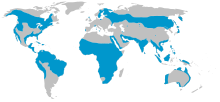| Osprey | |
|---|---|

| |
| American osprey (P. h. carolinensis) standing on its nest | |
| Call | |
| Scientific classification | |
| Domain: | Eukaryota |
| Kingdom: | Animalia |
| Phylum: | Chordata |
| Class: | Aves |
| Order: | Accipitriformes |
| Family: | Pandionidae |
| Genus: | Pandion |
| Species: | P. haliaetus
|
| Binomial name | |
| Pandion haliaetus | |

| |
| Global range of Pandion haliaetus | |
| Synonyms | |
|
Falco haliaetus Linnaeus, 1758 | |
The osprey (/ˈɒspri, -preɪ/;[2] Pandion haliaetus), historically known as sea hawk, river hawk, and fish hawk, is a diurnal, fish-eating bird of prey with a cosmopolitan range. It is a large raptor, reaching more than 60 cm (24 in) in length and 180 cm (71 in) across the wings. It is brown on the upperparts and predominantly greyish on the head and underparts.
The osprey tolerates a wide variety of habitats, nesting in any location near a body of water providing an adequate food supply. It is found on all continents except Antarctica, although in South America it occurs only as a non-breeding migrant.
As its other common names suggest, the osprey's diet consists almost exclusively of fish. It possesses specialised physical characteristics and unique behaviour in hunting its prey. Because of its unique characteristics it is classified in its own taxonomic genus, Pandion, and family, Pandionidae.
- ^ BirdLife International (2021). "Pandion haliaetus". IUCN Red List of Threatened Species. 2021: e.T22694938A206628879. doi:10.2305/IUCN.UK.2021-3.RLTS.T22694938A206628879.en. Retrieved 9 March 2022.
- ^ "osprey". The Chambers Dictionary (9th ed.). Chambers. 2003. ISBN 0-550-10105-5.
